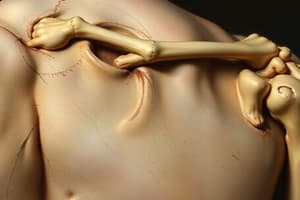Podcast
Questions and Answers
What is the gender distribution for traumatic anterior glenohumeral dislocations?
What is the gender distribution for traumatic anterior glenohumeral dislocations?
- 80% male, 20% female
- 72% male, 28% female (correct)
- 60% male, 40% female
- 50% male, 50% female
When is recurrent anterior glenohumeral dislocation more likely to occur?
When is recurrent anterior glenohumeral dislocation more likely to occur?
- After the age of 30
- After the age of 40
- Within 2 years of the first dislocation event (correct)
- Within 1 year of the first dislocation event
What is the main ligamentous restraint to anterior translation during shoulder dislocation?
What is the main ligamentous restraint to anterior translation during shoulder dislocation?
- Coracohumeral ligament
- Superior glenohumeral ligament
- Middle glenohumeral ligament
- Inferior glenohumeral ligament (correct)
What might be observed in the lateral deltoid region due to a shoulder dislocation?
What might be observed in the lateral deltoid region due to a shoulder dislocation?
What is a common mechanism of injury for traumatic anterior glenohumeral dislocations?
What is a common mechanism of injury for traumatic anterior glenohumeral dislocations?
Which test is associated with an increased risk of recurrent instability if positive six weeks after an anterior glenohumeral dislocation event?
Which test is associated with an increased risk of recurrent instability if positive six weeks after an anterior glenohumeral dislocation event?
What type of exercises should be commenced early for posterior dislocation?
What type of exercises should be commenced early for posterior dislocation?
What symptom may indicate posterior subluxation/instability?
What symptom may indicate posterior subluxation/instability?
What is the specific management approach if posterior dislocation is not relocated?
What is the specific management approach if posterior dislocation is not relocated?
Which muscles should often be focused on in cases of ongoing posterior instability signs and symptoms?
Which muscles should often be focused on in cases of ongoing posterior instability signs and symptoms?
What type of test can be used to assess posterior subluxation/instability?
What type of test can be used to assess posterior subluxation/instability?
Which imaging modality is the preferred choice for investigating associated pathology in a patient with traumatic anterior glenohumeral dislocation?
Which imaging modality is the preferred choice for investigating associated pathology in a patient with traumatic anterior glenohumeral dislocation?
What is the recommended approach for managing many dislocations successfully?
What is the recommended approach for managing many dislocations successfully?
In which age group should a clinician assume a rotator cuff tear until cleared in a patient with traumatic anterior glenohumeral dislocation?
In which age group should a clinician assume a rotator cuff tear until cleared in a patient with traumatic anterior glenohumeral dislocation?
Which scenario is most likely to result in anterior shoulder instability?
Which scenario is most likely to result in anterior shoulder instability?
What is the primary cause of posterior shoulder dislocation according to the text?
What is the primary cause of posterior shoulder dislocation according to the text?
What distinguishes subluxation from glenohumeral joint dislocation?
What distinguishes subluxation from glenohumeral joint dislocation?
Which factor should be considered alongside pathology associated with recurrence risk in patients with traumatic anterior glenohumeral dislocation?
Which factor should be considered alongside pathology associated with recurrence risk in patients with traumatic anterior glenohumeral dislocation?
What percentage of traumatic shoulder dislocations are classified as posterior dislocations?
What percentage of traumatic shoulder dislocations are classified as posterior dislocations?
Hill Sachs lesions are typically associated with which type of shoulder injury?
Hill Sachs lesions are typically associated with which type of shoulder injury?




